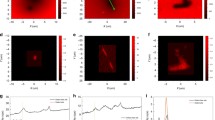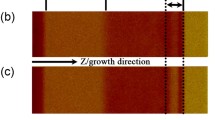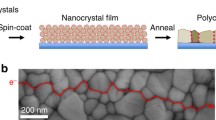Abstract
For non-destructive optical characterization, laser beam induced current (LBIC) microscopy has been developed into as a quantitative tool to examine individual photodiodes within a large pixel array. Two-dimensional LBIC microscopy, also generally called photocurrent mapping (PC mapping), can provide spatially resolved information about local electrical properties and p-n junction formation in photovoltaic infrared (including visible light) photodetectors from which it is possible to extract material and device parameters such as junction area, junction depth, diffusion length, leakage current position and minority carrier diffusion length etc. This paper presents a comprehensive review of research background, operating principle, fundamental issues, and applications of LBIC or PC mapping.
Similar content being viewed by others
References
Wallmark J T. A new semiconductor photocell using lateral photoeffect. Proc IRE, 1956, 45: 474–483
Bajaj J, Bubulac L O, Newman P R, et al. Spatial mapping of electrically active defects in HgCdTe using laser beam induced current. J Vac Sci Technol A, 1987, 5: 3186–3187
Musca C A, Redfern D A, Dell J M, et al. Laser beam induced current as a tool for HgCdTe photodiode characterization. Microelectron J, 2000, 31: 537–544
Redfern D A, Smith E, Musca C A, et al. Interpretation of current flow in photodiode structures using laser beam-induced current for characterization and diagnostics. IEEE Trans Electron Dev, 2006, 53: 23–31
Hu W D, Chen X S, Ye Z H, et al. Polarity inversion and coupling of laser beam induced current in As-doped long-wavelength HgCdTe infrared detector pixel arrays: Experiment and simulation. Appl Phys Lett, 2012, 101: 181108
Hu W D, Chen X S, Ye Z H, et al. Dependence of ion-implant-induced LBIC novel characteristic on excitation intensity for long-wavelength HgCdTe-based photovoltaic infrared detector pixel arrays. IEEE J Sel Top Quant, 2013, 19: 4100107
Feng A L, Li G, He G, et al. The role of localized junction leakage in the temperature-dependent laser-beam-induced current spectra for HgCdTe infrared focal plane array photodiodes. J Appl Phys, 2013, 114: 173107
Redfern D A, Musca C A, Dell J M, et al. Correlation of laser-beam-induced current with current-voltage measurements in HgCdTe photodiodes. J Electron Mater, 2004, 33: 560–571
Redfern D A, Musca C A, Dell J M, et al. Characterization of electrically active defects in photovoltaic detector arrays using laser beam-induced current. IEEE Trans Electron Dev, 2005, 52: 2163–2174
Yin F, Hu W D, Zhang B, et al. Simulation of laser beam induced current for HgCdTe photodiodes with leakage current. Opt Quantum Electron, 2009, 41: 805–810
Redfern D A, Thomas J A, Musca C A, et al. Diffusion length measurements in p-HgCdTe using laser beam induced current. J Electron Mater, 2001, 30: 696–703
Musca C A, Redfern D A, Smith E, et al. Junction depth measurement in HgCdTe using laser beam induced current (LBIC). J Electron Mater, 1999, 28: 603–610
Gluszak E A, Hinckley S, Kamran E. Determination of junction depth and related current phenomena using laser-beam-induced current. Proc SPIE, 2004, 5274: 331–341
Hu W D, Chen X S, Yin F, et al. Analysis of temperature dependence of dark current mechanisms for long-wavelength HgCdTe photovoltaic infrared detectors. J Appl Phys, 2009, 105: 104502
Hu W D, Chen X S, Ye Z H, et al. Accurate simulation of temperature dependence of dark current in HgCdTe infrared detector assisted by analytical modeling. J Electron Mater, 2010, 39: 981–985
Zha F X, Zhou S M, Ma H L, et al. Laser drilling induced electrical type inversion in vacancy-doped p-type HgCdTe. Appl Phys Lett, 2008, 93: 151113
Zha F X, Li M S, Shao J, et al. Femtosecond laser-drilling-induced HgCdTe photodiodes. Opt Lett, 2010, 35: 971–973
Zhou S M, Zha F X, Guo Q T, et al. The morphology of micro hole pn junction in p-type HgCdTe formed by femtosecond laser drilling. J Infrared Millim Waves, 2010, 29: 337–341
Martyniuk M, Sewell R H, Westerhout R, et al. Electrical type conversion of p-type HgCdTe induced by nanoimprinting. Appl Phys, 2011, 109: 096102
Gluszak E A, Hinckley S. Contactless junction contrast of HgCdTe n-on-p-type structures obtained by reactive ion etching induced p-to-n conversion. J Electron Mater, 2001, 30: 768–773
Fang W, Ito K, Redfern D A. Parameter identification for semiconductor diodes by LBIC imaging. SIAM J Appl Math, 2002, 62: 2149–2174
Hong X K, Lu H, Zhang D B. Study on the structure characteristics of HgCdTe photodiodes using laser beam-induced current. Opt Quantum Electron, 2013, 45: 623–628
Bajaj J, Tennant W E, Newman P R. Laser beam induced current imaging of surface nonuniformity at the HgCdTe/ZnS interface. J Vac Sci Technol A, Vac Surf Films, 1988, 6: 2757–2759
Bajaj J, Tennant W E, Zucca R, et al. Spatially resolved characterization of HgCdTe materials and devices by scanning laser microscopy. Semicond Sci Technol, 1993, 8: 872–887
Redfern D A, Fang W, Ito K, et al. Low temperature saturation of p-n junction laser beam induced current signals. Solid-State Electron, 2004, 48: 409–414
Qiu W C, Cheng X A, Wang R, et al. Novel signal inversion of laser beam induced current for femtosecond-laser-drilling induced junction on vacancy-doped p-type HgCdTe. J Appl Phys, 2014, 115: 204506
Busenberg S, Fang W, Ito K. Modeling and analysis of laser beam induced current images in semiconductors. SIAM J Appl Math, 1993, 53: 187–204
Qiu W C, Hu W D, Lin T, et al. Temperature-sensitive junction transformations for mid-wavelength HgCdTe photovoltaic infrared detector arrays by laser beam induced current microscope. Appl Phys Lett, 2014, in press
Hu W D, Ye Z H, Liao L, et al. A 128×128 long-wavelength/mid-wavelength two-color HgCdTe infrared focal plane array detector with ultra-low spectral crosstalk. Opt Lett, 2014, 39: 5130–5133
Feng A L, Li G, He G, et al. Dependence of laser beam induced current on geometrical sizes of the junction for HgCdTe photodiodes. Opt Quantum Electron, 2014, 46: 1277–1282
Baugher B, Churchill H, Yang Y F, et al. Optoelectronic devices based on electrically tunable p-n diodes in a monolayer dichalcogenide. Nat Nanotech, 2014, 9: 262–267
Balasubramanian K, Burghard M, Kern K, et al. Photocurrent imaging of charge transport barriers in carbon nanotube devices. Nano Lett, 2005, 5: 507–510
Zhang Y P, Deng W, Zhang X J, et al. In situ integration of squaraine-nanowire-array-based schottky-type photodetectors with enhanced switching performance. ACS Appl Mater Interfaces, 2013, 5: 12288–12294
Buscema M, Groenendijk D J, Steele G A, et al. Photovoltaic effect in few-layer black phosphorus PN junctions defined by local electrostatic gating. Nature Commun, 2014, 5: 4651
Yu Y Q, Jie J S, Jiang P, et al. High-gain visible-blind UV photodetectors based on chlorine-doped n-type ZnS nanoribbons with tunable optoelectronic properties. J Mater Chem, 2011, 21: 12632–12638
Wang J L, Zou X M, Xiao X H, et al. Floating gate memory based monolayer MoS2 transistor with metal nanocrystals embedded in gate dielectrics. Small, 2014, doi: 10.1002/smll.201401872
Hu W D, Chen X S, Yin F, et al. Simulation and design consideration of photoresponse for HgCdTe infrared photodiodes. Opt Quantum Electron, 2008, 40: 1255–1260
Guo N, Hu W D, Chen X S, et al. Optimization for mid-wavelength InSb infrared focal plane arrays under front-side illumination. Opt Quantum Electron, 2013, 45: 673–679
Hu W D, Chen X S, Ye Z H, et al. An improvement on short wavelength photoresponse for a heterostructure HgCdTe two-color infrared detector. Semicond Sci Technol, 2010, 25: 045028
Wenus J, Rutkowski J, Rogalski A. 2D analysis of double layer heterojunction HgCdTe photodiodes. IEEE Trans Electron Devices, 2001, 48: 1326–1332
Orsogna D D, Tobin S, Bellotti E. Numerical analysis of a very long-wavelength HgCdTe pixel array for infrared detection. J Electron Mater, 2008, 37: 1349–1355
Keasler C A, Moresco M, Orsogna D D, et al. 3D numerical analysis of As-diffused HgCdTe planar pixel arrays. Proc SPIE, 2010, 7780: 77800J
Ji X L, Liu B Q, Xu Y, et al. Deep-level traps induced dark currents in extended wavelength InxGa1-xAs/InP photodetector. J Appl Phys, 2013, 114: 224502
Yin F, Hu W D, Quan Z J, et al. Determination of electron diffusion length in HgCdTe photodiodes using laser beam induced current. Acta Phys Sin, 2009, 58: 7885–7889
Ong V, Wu D. Determination of diffusion length from within a confined region with the use of EBIC. IEEE Trans Electron Dev, 2001, 48: 332–337
Bubulac L O, Tennant W E. Role of Hg in junction formation in ion-implanted HgCdTe. Appl Phys Lett, 1987, 51: 355–357
Bubulac L O. Dependence of junction formation on substrate in implanted HgCdTe. Appl Phys Lett, 1985, 46: 976–978
Arias J M, Zandian M, Bajaj J, et al. Molecular beam epitaxy HgCdTe growth-induced void defects and their effect on infrared photodiodes. J Electron Mater, 1995, 24: 521–524
Buell A A, Pham L T, Newton M D, et al. Physical structure of molecularbeam epitaxy growth defects in HgCdTe and their impact on two-color detector performance. J Electron Mater, 2004, 33: 662–666
Ahn Y H, Tsen A W, Kim B, et al. Photocurrent Imaging of p-n Junctions in Ambipolar Carbon Nanotube Transistors. Nano Lett, 2007, 7: 3320–3323
Balasubramanian K, Fan Y W, Burghard M, et al. Photoelectronic transport imaging of individual semiconducting carbon nanotubes. Appl Phys Lett, 2004, 84: 2400–2402
Freitag M, Tsang J C, Bol A, et al. Imaging of the schottky barriers and charge depletion in carbon nanotube transistors. Nano Lett, 2007, 7: 2037–2042
Xia F N, Mueller T, Golizadeh-mojarad R, et al. Photocurrent imaging and efficient photon detection in a graphene transistor. Nano Lett, 2009, 9: 1039–1044
Wu C C, Jariwala D, Sangwan V K, et al. Elucidating the photoresponse of ultrathin MoS2 field-effect transistors by scanning photocurrent microscopy. J Phys Chem Lett, 2013, 4: 2508–2513
Oriol L S, Dominik L, Metin K, et al. Ultrasensitive photodetectors based on monolayer MoS2. Nat Nanotech, 2013, 8: 497–501
Britnell L, Ribeiro R M, Eckmann A, et al. Strong light-matter interactions in heterostructures of atomically thin films. Science, 2013, 340: 1311–1314
Song X F, Hu J L, Zeng H B. Two-dimensional semiconductors: Recent progress and future perspectives. J Mater Chem C, 2013, 1: 2952–2969
Zeng H B, Zhi C Y, Zhang Z H, et al. “White” graphene: Boron nitride nanoribbons via boron nitride nanotube unwrapping. Nano Lett, 2010, 10: 5049–5055
Ahn Y, Dunning J, Park J. Scanning photocurrent imaging and electronic band studies in silicon nanowire field effect transistors. Nano Lett, 2005, 5: 1367–1370
Gu Y, Kwak E, Lensch J, et al. Near-field scanning photocurrent microscopy of a nanowire photodetector. Appl Phys Lett, 2005, 87: 043111
Miao J S, Hu W D, Guo N, et al. Single InAs nanowire room-temperature near-infrared photodetectors. ACS Nano, 2014, 8: 3628–3635
Dufaux T, Boettcher J, Burghard M, et al. Photocurrent distribution in graphene-CdS nanowire devices. Small, 2010, 6: 1868–1872
Howell S L, Padalkar S, Yoon K, et al. Spatial mapping of efficiency of GaN/InGaN nanowire array solar cells using scanning photocurrent microscopy. Nano Lett, 2013, 13: 5123–5128
Allen J E, Hemesath E R, Lauhon L J. Scanning photocurrent microscopy analysis of Si nanowire field-effect transistors fabricated by surface etching of the channel. Nano Lett, 2009, 9: 1903–1908
Luo L B, Chen J J, Wang M Z, et al. Near-Infrared light photovoltaic detector based on GaAs nanocone array/monolayer graphene schottky junction. Adv Funct Mater, 2014, 24: 2794–2800
Bonaccorso F, Sun Z, Hasan T, et al. Graphene photonics and optoelectronics. Nat Photon, 2010, 4: 611–622
Echtermeyer T J, Britnell L, Jasnos P K, et al. Strong plasmonic enhancement of photovoltage in grapheme. Nat Commun, 2011, 2: 458
Liu Y, Cheng R, Liao L, et al. Plasmon resonance enhanced multicolour photodetection by grapheme. Nat Commun, 2011, 2: 579
Luo L B, Zeng L H, Xie C, et al. Light trapping and surface plasmon enhanced high-performance NIR photodetector. Sci Rep, 2014, 4: 3914–3918
Fang Z Y, Liu Z, Wang Y M, et al. Graphene-antenna sandwich photodetector. Nano Lett, 2012, 12: 3808–3813
Miao J S, Hu W D, Guo N, et al. High-responsivity graphene/InAs nanowire heterojunction near-infrared photodetectors with distinct photocurrent on/off ratio. Small, 2014, in press, doi: 10.1002/smll.201402312
Guo N, Hu W D, Liao L, et al. Anomalous and highly-efficient InAs nanowire phototransistors based on majority carrier transport at room temperature. Adv Mater, 2014, in press, doi: 10.1002/adma.201403664
Lee E J, Balasubramanian K, Weitz R T, et al. Contact and edge effects in grapheme devices. Nat Nanotech, 2008, 3: 486–490
Yin Z Y, Li H, Jiang L, et al. Single-layer MoS2 phototransistors. ACS Nano, 2012, 6: 74–80
Lee H S, Min S W, Chang Y G, et al. MoS2 nanosheet phototransistors with thickness-modulated optical energy gap. Nano Lett, 2012, 12: 3695–3700
Choi W, Cho M Y, Konar A, et al. High-detectivity multilayer MoS2 phototransistors with spectral response from ultraviolet to infrared. Adv Mater, 2012, 24: 5832–5836
Buscema M, Barkelid M, Zwiller V, et al. Large and tunable photothermoelectric effect in single-layer MoS2. Nano Lett, 2013, 13: 358–363
Author information
Authors and Affiliations
Corresponding author
Rights and permissions
About this article
Cite this article
Qiu, W., Hu, W. Laser beam induced current microscopy and photocurrent mapping for junction characterization of infrared photodetectors. Sci. China Phys. Mech. Astron. 58, 1–13 (2015). https://doi.org/10.1007/s11433-014-5627-6
Received:
Accepted:
Published:
Issue Date:
DOI: https://doi.org/10.1007/s11433-014-5627-6




